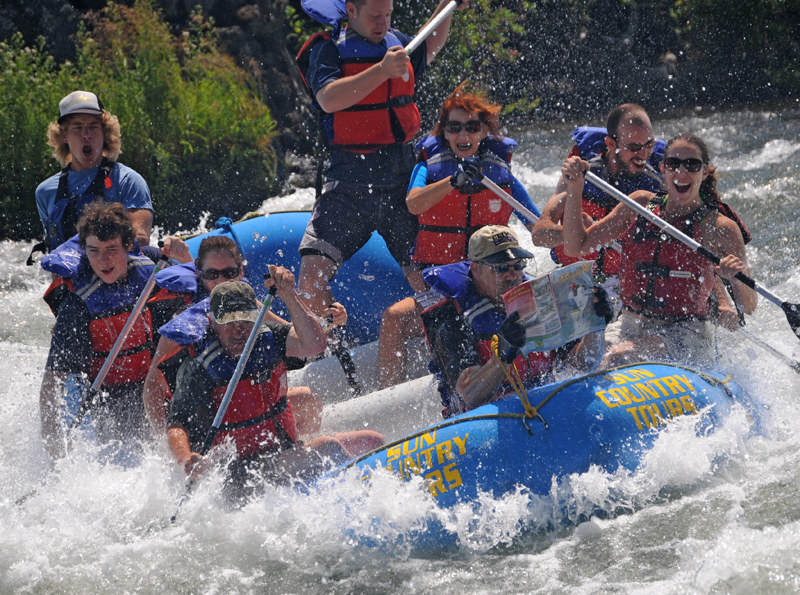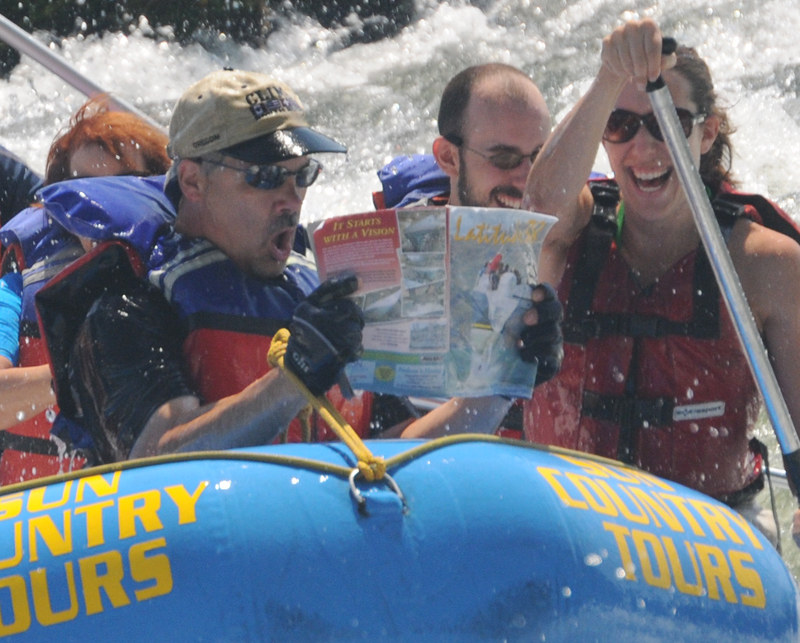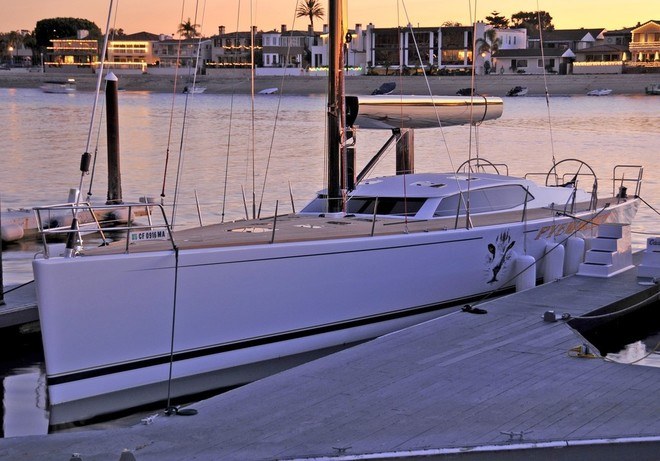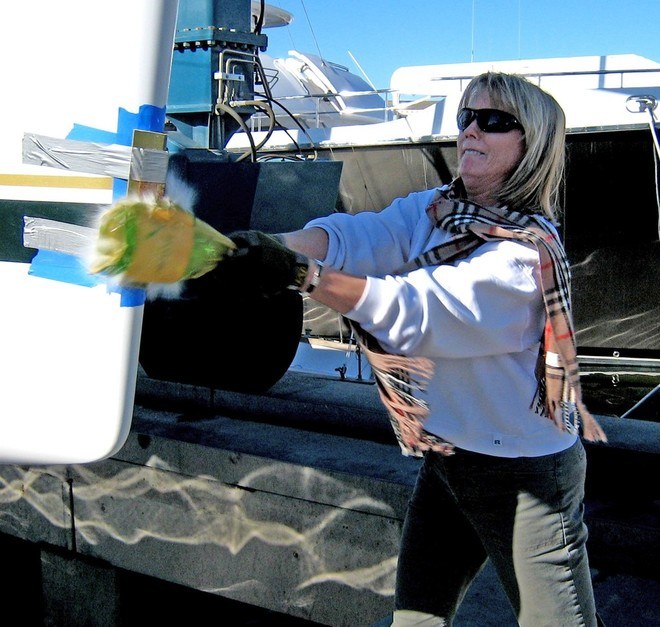
Raising the Rafters

"I work as a photographer for a river rafting company called Sun Country Tours based in Bend, Oregon," Scott Weber wrote in an email. "These shots were taken at a place called the Big Eddy Rapids, which is on the upper Deschutes River." Sun Country Tours posts a photographer at a spot in the rapids called The Notch, then offers prints to their customers after their trip.
"I saw someone reading a magazine as they came down The Notch," Weber continued. "It seemed very odd for someone to do this since the raft was approaching the most exciting and wettest part of the rapid. When I uploaded the photos, I zoomed in to see that he was reading Latitude 38! I really got a chuckle since I used to sail out of Half Moon Bay on a Brown 31 trimaran and looked forward to getting my monthly copy of your magazine.

"I don’t know who the guy is but I suspect he bought the photos and will be sending them to you as well. I wanted to beat him to the punch. I doubt he would ever have imagined that the photog used to read the same publication and knew what he was up to! He should really get a good laugh about this."
Are you the daredevil enjoying the May issue of Latitude while your rafting buddies do all the hard work? If so, email LaDonna and tell us about your trip!
A “Cleansing” in the Rio Dulce
Roy McNett, editor of the Rio Dulce Chisme-Vindicator, reports the latest on the events following the murder of Anchorage-based cruiser Daniel Dryden:
"Local justice — it’s not a pretty word — may have been served on the night of August 14, when two men were killed in a shooting in the small town of Seja, about five miles from Fronteras and the Rio Dulce. The two men are believed to have been involved in the August 9 robbery and murder of Daniel Dryden on the Southern Cross 39 Sunday’s Child. Nancy, Dryden’s wife, was seriously injured in the attack, but is recovering in a hospital.
©2008 Latitude 38 Media, LLC
"Four men were reportedly involved in the attack on Drydens’ boat, which was anchored a short distance offshore. Two of those were reported arrested on August 14 in the village of Esmeralda, and are now in the custody of Guatemalan police. The remaining two were believed to have been killed last night in the Seja shooting. Their identities have not been made available, but several sources of the Rio Dulce Chisme-Vindicator indicate this was a ‘cleansing’ of the Dryden murder."
We’re not positive what "cleansing" means in this context, but we assume it means the police, or somebody acting for the police, acted as an on-the-spot judge, jury, and executioner for the suspects. From start to finish, what a horrible, senseless chain of events.
Roy’s New Cat

Roy Disney is one of those guys who just can’t seem to get enough of ocean racing — even when he doesn’t personally go along. You’ll recall that he was going to retire from the game after the ‘05 TransPac, but then got all fired up, chartered his MaxZ86 Pyewacket back from Orange Coast College, turbo’d it like a seagoing top-fuel dragster and — without him aboard — the boat did the ’07 TransPac, earning the 78-year-old Disney his third barn door (first to finish) trophy in 15 TransPacs. He’s done so many Mexico races on four different Pyewackets that he’s lost count.
Now he’s back with yet another ‘magic cat’. But the fifth Pyewacket is a big departure from the others. For one thing, at 60 feet, she’s smaller. She’s also much more comfortable in a — dare we say it? — cruisey sort of way.

“This boat’s kind of racy but it’s not a racing boat,” he said at the launch of the Reichel/Pugh-designed 60-footer, which was built at Westerly Marine in Santa Ana and launched last December. That means a carbon fiber mast and twin wheels, but also a cherrywood interior, teak decks and a hydraulic lifting keel — 13.5 feet down, 8.5 feet up — which will allow access into more out-of-the-way ports than the old ‘Pye’s could ever fit into.
The first big event for the boat is, fittingly, Del Rey YC’s PV09 International Race Series, a four-leg, 1,034-mile racing series down the Mexican coast with layovers at Turtle Bay, Mag Bay, Cabo and the finish, Puerto Vallarta. Pyewacket is one of 33 boats entered so far in the 20th biennial edition of the event, which is sponsored this year by Corum Swiss Timepieces. Leg 1 starts on January 31.
Roy will do the race with wife Leslie DeMeuse-Disney and a smallish crew with a minimum of pros. “This is a friendly race, so we want to bring our friends,” he said. "But I’m also really curious to see how fast the boat is.”
Tunnicliffe Takes Only U.S. Gold
On Monday, Anna Tunnicliffe hit a home run on the penultimate leg of the women’s singlehanded medal race at the Quingdao Olympics, hitting a massive left shift that sent her from zero to hero. Leading the regatta going into the race, Tunnicliffe tried a risky start — at 30 seconds to go, she jibed away from a safe leeward position a little over halfway down the line from the committee boat. Looking like she was going to be late, Tunnicliffe snuck in to weather of Kiwi Jo Aleh, who was over the line. When the individual recall flag went up, Tunnicliffe thought she may have been as well, and restarted. This left her third to last around the weather mark, out of contention for a medal. After losing another boat on the run, she banged that corner until she was reaching into the weather mark on port tack, having passed five boats in the process and back in position for a gold. On the final run, she passed another boat to take second in the race, the second U.S. medal in sailing, and the only gold.
Excepting Tunnicliffe’s gold and Zach Railey’s well-earned silver in the Finn, the U.S. Sailing Team overall did not have a good regatta — and that’s an understatement. The only event where an American sailor had good regatta, besides those two, was in the 49er, where Tim Wadlow and Chris Rast sailed pretty well — reeling off three straight bullets at one point. They were contenders going into the medal race until gear failure followed a great start, causing them to not make the finish deadline. We actually enjoyed watching that much-ballyhooed race — seeing every top-ranked team flip gave a great indication of how gnarly the sea state was, and the actual challenge of sailing the boats is what the games should be about. We wholeheartedly disagree with commentator Gary Jobson’s "this is pathetic," comment on the final leg of that race.
John Dane and Austin Sperry’s ‘no-check-goes-unwritten’ Star campaign failed when their extremely light-air-geared set-up was greeted with decidedly un-Qingdao conditions — breeze in the twenties and sloppy seas. The pair didn’t qualify for their medal race ending up in eleventh. John Lovell and Charlie Ogletree’s code zero spinnaker turned out to be a non-starter for the same reason. Inexplicably, they used both their measurement tags on those little-tested sails, instead of measuring a conventional kite as well.
In the men’s boardsailing, Ben Barger managed a bottom-third finish, also not qualifying for the medal race. Same story in the women’s, where Nancy Rios was next to last. Neither U.S. 470 team managed to qualify for their medal race, despite some promising results in international competition leading up to the event. The Yngling team of Sally Barkow, Debbie Capozzi and Carrie Howe finished in seventh, not fifth as we previously reported, with an inconsistent regatta which nontheless put them in the bronze position going into their disasterous medal race. Andrew Campbell failed to qualify for the men’s singlehanded medal race, finishing 25th of 43 after a black-flag penalty and DSQ.
Well, there’s always Weymouth in 2012. . . .
